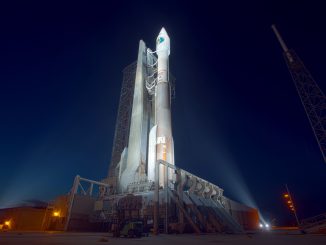
CAPE CANAVERAL — The fifth and final satellite for the U.S. Navy’s new mobile network to provide rugged smartphone communications to all branches of the military has arrived at the launch site for blastoff in May.
The Mobile User Objective System satellite No. 5, built to be an on-orbit spare, was flown aboard a C-5 Galaxy aircraft March 3 from its Lockheed Martin factory in Sunnyvale, California to Cape Canaveral, Florida.
Liftoff is targeted for May 5 atop a United Launch Alliance Atlas 5 rocket flying in its mightiest 551 configuration with five strap-on solid-fuel boosters.
The launch will be occur some time during an unclassified period that runs from 11:46 a.m. to 3:46 p.m. EDT.
The mission will complete the MUOS launch series that began in 2012 to form a global communications infrastructure in geosynchronous orbit 22,300 miles up. All the satellites have used the Atlas 5 to get into space.
MUOS 1 — Launched Feb. 24, 2012 (Coverage: Pacific Ocean region)
MUOS 2 — Launched July 19, 2013 (Coverage: Continental U.S.)
MUOS 3 — Launched Jan. 20, 2015 (Coverage: Atlantic Ocean region)
MUOS 4 — Launched Sept. 2, 2015 (Coverage: Indian Ocean region)
MUOS 5 — Planned for May 5 (Coverage: Indian Ocean region)
“As MUOS-5’s launch approaches, MUOS-4 is preparing to begin operations on-station, enabling MUOS’ near-global coverage,” said Mark Woempner, program director of Lockheed Martin’s Narrowband Communications mission area.
“We are proud that we will soon be providing our mobile forces access to the system’s enhanced communications capabilities from nearly anywhere, including further into polar regions than ever before.”
MUOS is the nation’s next-generation narrowband tactical satellite communications system, providing 3G cellphone features to warfighters on the move.

“Mobile forces, equipped with MUOS terminals, will soon be able to communicate with each other – including voice, data and exchanging imagery – real-time, virtually anywhere on the Earth,” said Iris Bombelyn, Lockheed Martin’s vice president for Narrowband Communications. “This is a tremendous upgrade in communications capabilities over what currently exists for our nation and our allies.”
MUOS No. 5 was taken to the commercial Astrotech processing facility in Titusville to be unpacked from its shipping container. It will undergo final testing, the loading of maneuvering fuel and encapsulation in the rocket’s 18-foot-diameter composite nose cone.
The Atlas 5 first stage and Centaur upper stage will be brought together starting in mid-April at the Vertical Integration Facility at Cape Canaveral’s Complex 41. The satellite will be mounted on top to finish assembling the 206-foot-tall rocket at the end of April.
Atlas rockets have conducted 23 launches with communications satellites for the Navy since 1978.
Our Atlas archive.



